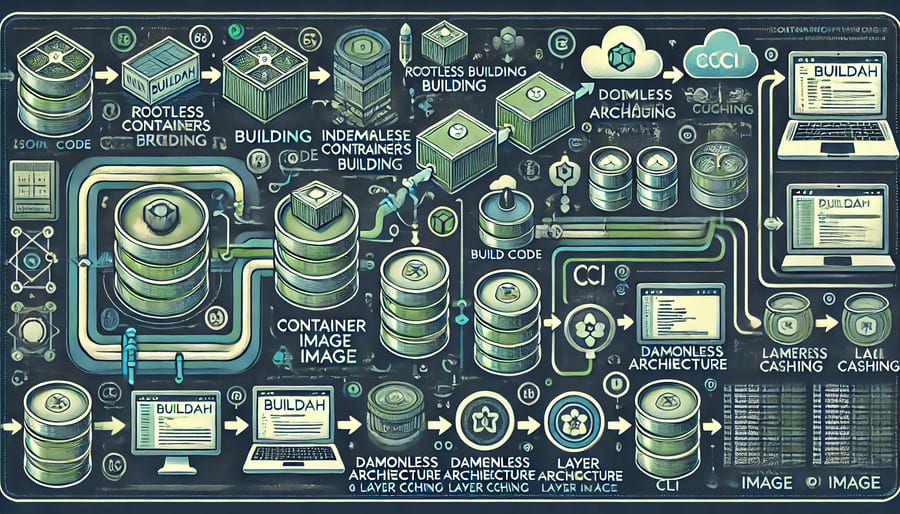Buildah: The Flexible Tool for Building OCI Container Images

Buildah is a powerful, open-source tool designed specifically for building Open Container Initiative (OCI) compliant container images. Unlike monolithic container engines, Buildah focuses exclusively on building, manipulating, and pushing container images, offering developers greater flexibility and control over their containerization workflow.
Buildah stands out in the container ecosystem due to its unique approach. While Docker combines multiple container operations into a single daemon, Buildah follows the Unix philosophy of doing one thing well: building images. This specialized focus brings several advantages:
- Daemonless architecture: Buildah doesn’t require a persistent background service to function, reducing resource overhead and security concerns.
- Rootless building: Images can be built without root privileges, improving security and enabling containerization in restricted environments.
- OCI compliance: All images built with Buildah follow industry standards, ensuring compatibility across container runtimes.
- Flexible build process: You can construct container images in a script-friendly, step-by-step manner.
Installing Buildah is straightforward on most Linux distributions:
# Fedora/RHEL/CentOS
sudo dnf install buildah
# Ubuntu/Debian
sudo apt-get install buildah
Building your first container image with Buildah follows a simple pattern:
# Create a new container from a base image
container=$(buildah from fedora:latest)
# Mount the container's filesystem
mountpoint=$(buildah mount $container)
# Install packages in the container
buildah run $container dnf install -y nginx
# Configure the container
buildah config --port 80 $container
# Commit the container to an image
buildah commit $container nginx-custom
# Push to a registry (optional)
buildah push nginx-custom docker://registry.example.com/nginx-custom
Buildah complements other container tools rather than replacing them entirely:
- Buildah vs. Docker: While Docker combines build, run, and management functions, Buildah focuses solely on building images, giving you more granular control over the build process.
- Buildah vs. Podman: These tools work perfectly together—Buildah builds the images, Podman runs them. Both share the same underlying libraries and can be used interchangeably for many tasks.
- Buildah vs. Kaniko: Unlike Kaniko (designed specifically for building images within containers), Buildah works natively on the host system, though both enable containerized builds.
Buildah truly shines when leveraging its advanced capabilities:
# Create a container from scratch (no base image)
container=$(buildah from scratch)
# Add your application binary
buildah copy $container ./myapp /app/myapp
# Configure entrypoint
buildah config --entrypoint '["/app/myapp"]' $container
# Commit to create a minimal image
buildah commit $container myapp:latest
Buildah supports multi-stage builds similar to Docker but with more flexibility:
# Build stage
build_container=$(buildah from golang:1.18)
buildah run $build_container go build -o /app main.go
# Runtime stage
runtime=$(buildah from alpine:latest)
buildah copy --from=$build_container $runtime /app /app
# Configure and commit
buildah config --entrypoint ["/app"] $runtime
buildah commit $runtime myapp:latest
Buildah works particularly well with Ansible for declarative image building:
# Ansible playbook for Buildah
- name: Build container image
hosts: localhost
tasks:
- name: Create container
command: buildah from fedora:latest
register: container_id
- name: Install packages
command: "buildah run {{ container_id.stdout }} dnf install -y nginx"
- name: Commit image
command: "buildah commit {{ container_id.stdout }} nginx-custom"
To get the most from Buildah, follow these best practices:
- Use layers efficiently: Group related commands to minimize the number of layers and reduce image size.
- Leverage bind mounts: Use bind mounts for build artifacts that shouldn’t be included in the final image.
- Consider rootless builds: When security is a concern, use rootless mode to minimize privilege requirements.
- Script your builds: Buildah’s command-line interface makes it perfect for integration into CI/CD pipelines.
- Clean up regularly: Use
buildah rmandbuildah rmito remove unused containers and images.
Buildah represents a significant evolution in container image building technology. Its focused approach, OCI compliance, and flexible architecture make it an excellent choice for developers who want more control over their container image creation process. Whether you’re building images for production deployment, development environments, or specialized applications, Buildah provides the tools needed to create efficient, secure container images that meet your exact requirements.
#ContainerTechnology #Buildah #OCI #ContainerImages #DevOps #Docker #Podman #CloudNative #Kubernetes #CICD #ContainerSecurity #RootlessContainers #OpenSource #RedHat #ContainerBuild #DevOpsPipeline #CloudDeployment #ContainerOrchestration #MicroservicesArchitecture #LinuxContainers